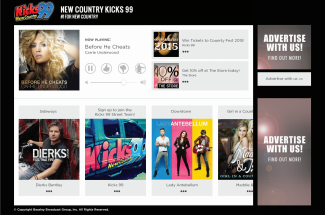 Clip Interactive, which has built its business on building interactive mobile apps for broadcast radio stations, announced that it is expanding its product line to include desktop and mobile browsers. This interactive web player will work on computers and mobile device browsers (Android and iOS), bypassing the need for users to download a station-specific mobile app.
Clip Interactive, which has built its business on building interactive mobile apps for broadcast radio stations, announced that it is expanding its product line to include desktop and mobile browsers. This interactive web player will work on computers and mobile device browsers (Android and iOS), bypassing the need for users to download a station-specific mobile app.
The company expects to roll out this product to 400 radio stations in 12 twelve broadcast groups this year. From that business expansion, Clip Interactive projects creating $55-million in new and incremental revenue for its partner stations in 2015.
“One hundred percent of a station’s content can now be made richly interactive including music, talk, contests, events, sports and specialized artist content,” said Bill Freund, chief revenue officer at Clip Interactive.
The company goal, to create a “total audience platform,” falls in line with a consumer need to simplify access to desired content among thousands of choices. Clip’s initiative also plants a stake in the ground on the side of mobile browser use, which advocates say is a better solution than cluttering a device’s memory with many brand-specific apps. With a responsive web player, the browser is the app, already built into the device. (Clip Interactive apps will remain in the product lineup, and are a good bet for stations with engaged and motivated users.)
The advantage to stations is that Clip’s interactive platform becomes available to all stream users, including those who resist downloading a station app.
When RAIN News spoke to CEO Michael Lawless in September, he noted that Clip Interactive had generated over a million dollars of incremental revenue for its radio group partners. The total 2014 number is now reported to be $4-million.
Clip Interactive’s feature set includes interactivity that isn’t often found in station websites, such as contests. User input extends to advertisements, where marketers can attract user actions with surveys and other calls to action. The company asserts that interactive features drive engagement with marketing messages, raising the value to advertisers.
